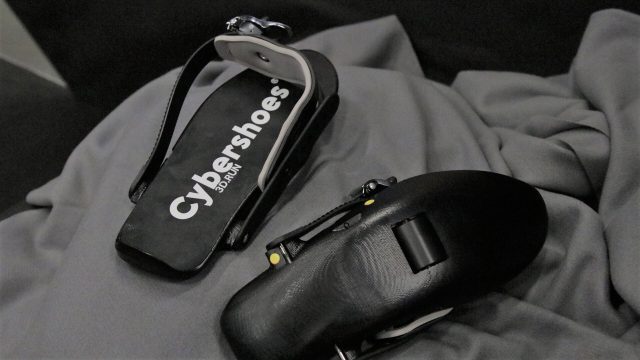VR treadmills are usually pretty bulky, expensive, and have a questionable utility outside of the initial wow moment of seeing one in action. Vienna-based Cybershoes however are aiming to get your feet into the game with a pretty simple concept that is less silly than it appears on first blush.
I got a chance to pop into the Cybershoes booth at this year’s Gamescom where a decent crowd had already formed around the VR users strangely moving their feet back and forth while seated.
Strapping the weighty plastic soles onto my sneakers, which were secured tight with snowboarder style quick straps, it was my turn to play a couple of minutes of Doom VFR (2017) on HTC Vive and peddle my feet, spinning the barrel-shaped wheel either backwards or forwards. From a physical standpoint, the results were pretty positive, as I naturally moved my feet as if I were running in place, spinning the little wheel underneath with ease.
While it was a simple setup experience, and moving forward and backwards was a breeze, the experience does leave something to be desired. Because you’re sitting on a swivel-style bar stool, if you want to turn in VR—assuming the game doesn’t support so-called snap-turning—it means you have to physically rotate yourself with your feet to face the direction you want to go, which isn’t great for when you have to make quick turns.
That said, you will need some way to suspend the cable over your head so it doesn’t get tangled around you during play. The demo space was outfitted with a makeshift cable guide re-purposed from IKEA’s Regolit lamp holder, which the company suggests using; they’ll also be suggesting a few chair models when the project makes its way to Kickstarter in September.
As for the shoe’s construction, I found them to be really quite sturdy. Milled from a single block of conductive plastic, the shoes are designed to both hold up to 100kg (~220lbs) and eliminate static discharge—something that’s extremely important, as you are essentially rubbing your feet on the carpet and potentially storing static charge throughout your game session.
The padded straps are essentially plucked from snowboarding boots, which allow for easy cinching and release—a good thing, considering you probably shouldn’t walk around your house with the things still on your feet for fear of faceplanting. Enterprise users will also likely appreciate the fact that they don’t have to strap unwitting first-timers into anything elaborate, or require users to wear special low-friction shoes like in some VR treadmills.
The shoe’s single barrel-style wheel seemed to feature interior ball bearings as well, the same way a skateboard wheel spins effortlessly. Cybershoes CEO Michael Bieglmayer told me that the company at first wanted to go with a laser setup, like those found in computer mice, to reduce the chance of mechanic wear even more, but the variability of user’s ground texture essentially made this a non-starter.
In the end, the idea is essentially to reduce VR-related discomfort while making things more immersive by letting you ‘walk’ in VR. Cybershoes basically accomplishes this, and appears to be well on its way to full production, as the version I tried at Gamescom was a near-final prototype. While Cybershoes aren’t a perfect solution, the device makes a compelling case for lighter, space-saving locomotion controllers—one that checks many of the same blocks as VR treadmills at this point. Starting at less than $300, it may be just at the right price-point for VR enthusiasts with less square footage than disposable income too.
The company’s Kickstarter is slated to arrive in September which ought to shed more light on the project’s funding tiers, final price and delivery date.


